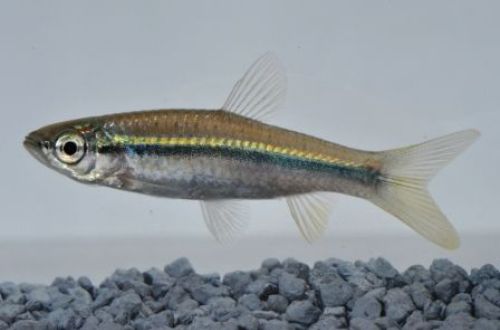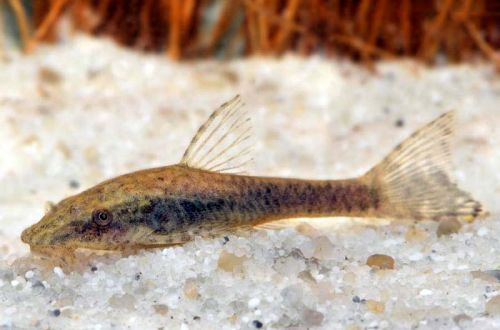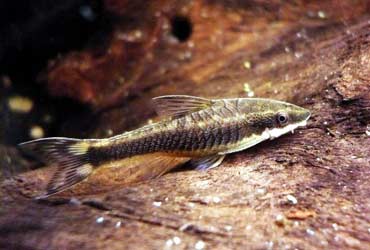
striped rasbora
Striped Rasbora or Indian Rasbora, scientific name Rasbora daniconius, belongs to the Cyprinidae family. This species does not differ in colorful colors in comparison with its relatives, however, it may deserve the attention of an aquarist. Fish scales have a high light reflection rate, so a flock of a dozen individuals will create a wonderful sparkling effect that will undoubtedly decorate any aquarium.

Contents
Habitat
Fish were discovered in the first half of the 19th century in Southeast Asia in the Mekong, Chao Phraya and Salween rivers, as well as in the Indus River. They live in rivers with a sandy bottom and slow flow in rather muddy water. They are found not only in large river systems, but even in ditches near human settlements, in flooded fields during the rainy season and in brackish waters. They form large flocks and feed on small aquatic insects.
Description
A slender fish of medium size, reaches a length of about 9 cm, the rapid shape of the body indicates high activity. The fins are small, usually yellow. The predominant color of the body is silvery with an olive tint. In males, the abdomen is light, in females it is yellow or reddish. A characteristic feature is the presence of a dark line passing through the entire body from head to tail, against a golden background. The scales of the fish have a high rate of light reflection, which gives the impression that the fish are sparkling during movement.
Food
The Striped Rasbora is not picky about food, and will gladly accept any kind of live, frozen and dry industrial food. A diet of dry food (granules, flakes) can be diluted with herbal supplements, such as lettuce. Lettuce is first dipped in boiling water to soften it, then finely chopped and served in a feeder. It is also recommended to feed your pets live food such as bloodworms.
Maintenance and care
Despite the fact that in nature fish live in murky water, in an aquarium it should be clean, without any impurities. A powerful filter is able to effectively purify the water, as well as create a moderate current (it should not be strong), allowing the fish to be in good shape. A filter with peat-based filter material is recommended as it further acidifies the pH value. Once a month, the water should be renewed by half and the soil should be cleaned with a siphon. The lighting is bright, short-term (no more than 30 minutes at a time) direct sunlight is allowed.
Substratum of sand or fine gravel with a few scattered smooth stones or pebbles. Plants are varied – small-leaved and broad-leaved, planted in dense groups, this provides a sense of security for the fish. Provide plenty of space for swimming in medium water, don’t overdo the vegetation. An additional imitation of the natural habitat is bamboo (specially prepared for use in aquariums), which can be placed along the walls, like reed beds along the coastline.
A schooling species, a prerequisite is the joint maintenance of at least 6 individuals, with a single content, the fish begins to wither and becomes susceptible to disease. Within the species, there is competition among males for the attention of females, and various skirmishes are likely, but they never lead to injury.
The fish are peaceful, but active, therefore, species similar in size and temperament should be selected as neighbors, and some types of catfish are also suitable.
Sexual differences
Males are smaller and more slender than females, the color of the abdomen is light, while in females it is yellowish or red.
Breeding / breeding
Like the rest of the carp family, Indian Rasbora does not show parental care and can eat its own eggs, so a separate spawning tank is required. A capacity of 40 liters is quite sufficient, from equipment: a heater, an aerator, a simple mechanical filter. Decoration: soil of small pebbles and thickets of small-leaved plants. From the latter, create several zones, for example, in each corner.
Spawning can begin at any time, the signal is increased feeding on meat products for 2-3 weeks and an increase in temperature by 2 ° above normal, set water hardness at 12 ° dH. When the fish are ready to spawn, the abdomen of the females swells with eggs, and the males begin active pursuits of their chosen ones. At this point, the couple should be transplanted into a separate tank, where the water parameters should repeat the parameters of the main aquarium.
When the fish get used to the new place, the couple hides among the plants, where they lay their eggs. At the end of spawning, the fish are returned to the general aquarium and the temperature is lowered to normal.
The fry appear within 3-4 days, and already on the third day they begin to swim freely in the tank. Feed microfood for fry.
Diseases
Under optimal living conditions, diseases do not occur, but a decrease in water quality, even for a short time, can provoke diseases. The most common: dropsy, fin rot, ichthyophthyriasis. Read more about symptoms and treatments in the Aquarium Fish Diseases section.





